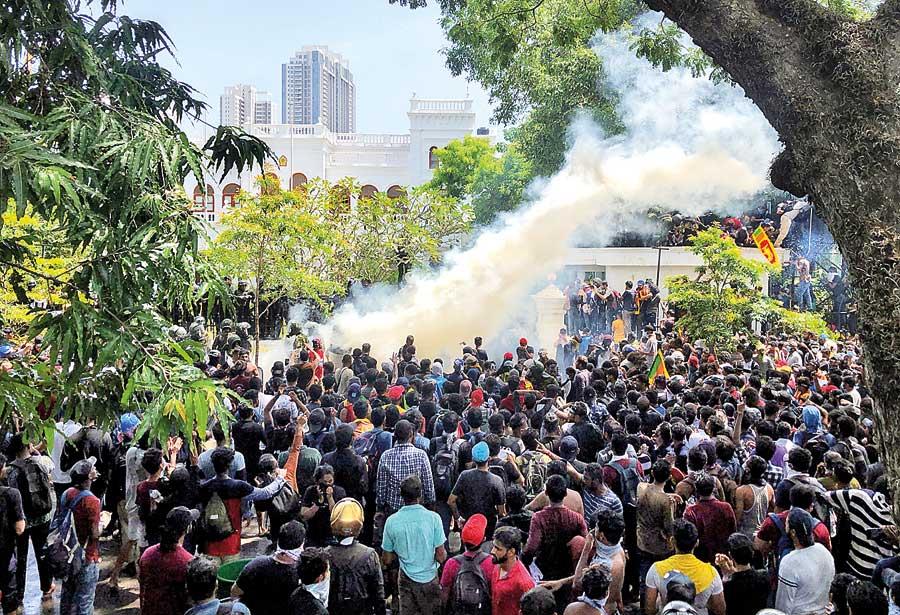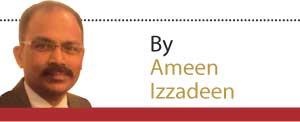Reply To:
Name - Reply Comment

Demonstrators brave tear gas to storm the office of Prime Minister Ranil Wickremesinghe. Reuters/Adnan Abidi
People’s power is democracy and democracy is people’s power. Yet these notions which underscore that sovereignty lies in the people can be best realised only when they are exercised with restraint and responsibility.
sovereignty lies in the people can be best realised only when they are exercised with restraint and responsibility.
People’s power or democracy when unchecked could lead to mob rule. We saw the vulgar display of mobocracy in the supporters of the former United States President Donald Trump when they stormed Capitol Hill on January 6 last year in blatant defiance of constitutional governance. Certainly, we do not want Sri Lanka’s people-power movement, call it a revolution, struggle, or Aragalaya, to be lumped together with the violent insurrection of Trump’s rightwing extremists.
Sri Lanka’s people’s power movement began in the kitchen and then spread to the streets with the social-media-savvy youths deciding to tear down the wall of fear built around the Rajapaksa name. With overflowing support from the suffering people, they stayed focused on their determination to oust the Gotabaya Rajapaksa government which had miserably failed to provide answers to their burning problems. What began as a trickle at Kohuwala and other main junctions, the silent vigils and protests spread to Colombo’s Independence Square and outside President Rajapaksa’s Mirihana private residence. It caused a tectonic shift in the Rajapaksa plateau. Within weeks, it emerged as a people-power tsunami at the Galle Face Green. It gave the protesters the confidence that their campaign was capable of ousting the rulers, notwithstanding the Rajapaksas’ war-winning credentials which they mistakenly believed would give them a cover to hide their wrongdoings, incompetency, failures, and criminal negligence that caused the economic catastrophe.
Sadly, even as President Rajapaksa, shaken by the history-making people-power tsunami on July 9, fled the country under the predawn darkness of Wednesday, the victory of the people’s power protests came to be tarnished. As government building after government building was stormed, questions were being raised as to what happened to the peaceful nature of the people-power struggle that triumphantly witnessed the downfall of the Rajapaksa political dynasty and the collapse of the once unassailable political fortress of the Sri Lanka Podujana Peramuna which captured power by mesmerising 6.9 million gullible voters with empty promises and anti-Muslim lies and deceptions.
How did the peaceful Aragalaya protests take the shape of mob rule? Who hijacked the apolitical struggle rooted in the suffering masses’ hope for economic relief?
How come the open, democratic and horizontal nature of the Aragalaya leadership became a vertical and dictatorial leadership dominated by university student groups, youth movements, and trade unions affiliated to the Janatha Viumukthi Peramuna and the Frontline Socialist Party also known as the Peratugamis?
Are they attempting to achieve through the Aragalaya what they failed to achieve through the two armed insurrections in 1971 and 1988-90?
"People’s power should protect itself from people’s power. It should not lead to ochlocracy or government by the mob which intimidates legitimate authorities. We saw this in Wednesday’s events which did ignite fears of an unfolding political coup"
Is the storming of the Presidential Secretariat, the President’s House, Temple Trees, the Prime Minister’s office, Parliament, and a state media institution an objective of the original Aragalaya movement or is it the work of the Aragalaya hijackers, who are now trying to claim a stake in the government through a people’s council lacking any legal or constitutional authority?
Except for the diehard Rajapaksa cronies, almost all Sri Lankans represent the Aragalaya. The movement should be a stand-by arrangement and an on-call informal pressure group to send warnings to politicians who think they can indulge in deception, corruption, and political thuggery and get away with them.
Any ad hoc or hurriedly formed people’s council will only spell disaster. Who will be the members of the people’s council and how will they be chosen? How will they react if the government decides to open the energy sector to foreign investors? Won’t they cause delays in the decision-making process, when the situation demands a quick response? What guarantees do we have that the council’s members are not immune to the manipulations of foreign powers trying to further their geopolitical goals?
The virtue of the Aragalaya movement should lie in the peaceful nature of the protest and in its commitment to uphold constitutionalism.
What is meant by constitutionalism is not merely adherence to the text of the constitution. Constitutionalism not only means that government can and should be legally limited in its powers; and that its authority or legitimacy depends on its observing these limitations. In contrast, constitutionalism calls for constant vigilance against the vagaries of democracy. In other words, it displays democracy’s distrust of democracy.
Similarly, people’s power should protect itself from people’s power. It should not lead to ochlocracy or government by the mob which intimidates legitimate authorities. We saw this in Wednesday’s events which did ignite fears of an unfolding political coup.
This article is not an attempt to defend the establishment or Acting President Ranil Wickremesinghe, who is likely to face a fate that has befallen the Rajapaksas. Like the Rajapaksas, he, too, misled the people. The Yahapalana government, of which he was the prime minister, did not care to fulfil its promise to unearth the corrupt deals of the Rajapaksas.
Most likely, Wickremesinghe will be history when Parliament elects a new president next Wednesday. So let the constitutional process take its course. But, come to think of it, is there in the present parliament, an MP who is fit enough to be the president we the people have pictured in our mind? That we do not have a clear answer to this question is a testament to our political bankruptcy, the result of 74 years of a depraved political culture in our country. To use the Aragalaya terminology, we need a system change now.
But this system change should come through constitutional means. In a democracy, the constitutional process should be followed even if the devil heads the government. This is the way to restore stability, which is an essential requirement to undertake measures to provide relief to the people gripped by hardships and end multiday-long waits for fuel and cooking gas.
There is no argument that mob rule is a threat to democracy and not a solution to the crisis. In general, people-power revolutions end tyranny and restore the rule of law and constitutionalism through radical reforms.
Bosnian political theoretician Jasmin Hasanović defines mob rule or ochlocracy as the direct rule of the mob or masses, or, perhaps, its effective ability to have an indirect but crucial influence on the government and, therefore, it is a form of tyranny. There is a thin line between ochlocracy and people-power uprising.
The Aragalaya protesters should be cautious not to cross this thin line. This is also the concern expressed by civil society groups that are part of the Aragalaya.